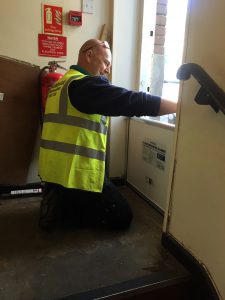Empowering resilience
Large scale defences can’t protect against all types of flooding. Local authorities are also short on cash and space to build them. Flood risk consultant Liz Gent looks at one example from the UK where we strengthened an entire community’s flood resilience by protecting individual properties.

In Southend-on-Sea in Essex, UK, extreme rainfall from climate change, overburdened drainage systems and seafront sewers that can become tide-locked have led to surface water flooding in hundreds of homes in the area, with EA figures estimating that up to 1,062 properties in the borough could be at high risk of surface water flooding in the future.
Protecting Southend
Through our work with Southend-on-Sea Borough Council in developing their local flood risk management plan, it became clear that installing property level protection (PLP) — one of the most effective ways to reduce the risk of surface water flooding from extreme rainfall — would be the best option to protect the local community.
Not only would a larger scheme such as building a floodwall be ineffective in the local built environment, it is also considered more cost-effective in the long run to make individual properties more resilient to floods, rather than paying for repairs after a flood happens.
Borough-level help
Working with the council’s emergency planning team, we identified property owners who could apply for Defra’s Repair and Renew Grant, which gave up to £5,000 to individual homeowners and businesses across the UK who experienced flooding in the 2013 to 2014 financial year.
Instead of expecting individual homeowners to apply for funding themselves, Southend applied for the funding at a borough level. While taking the pain out of the application process, it also ensured as many homes as possible would benefit.
The right support
Installing PLP can be daunting for local authorities; often they simply don’t have enough resources to identify, offer and deliver PLP to individual property owners on a neighbourhood or community scale. Likewise, homeowners may not know which measures are suitable, or can’t afford them.
That’s why it’s important to pull on consultancy support from those who have done it before and understand the pitfalls, strengths and benefits they can bring to entire communities.
Resilience on the ground

Within five months, we helped fit 160 properties across the borough with bespoke PLP measures, including flood-proof doors, automatic airbricks, raising of internal wiring, and waterproofing of walls — something that prior to our partnership with the council would not have happened under any other grant in aid or large scheme development.
While resistance measures such as flood resistance doors will keep floodwater out of properties, resilience measures such as raised internal wiring, will help limit any potential, significant damage.
Shared risk and responsibility
It was only through our conversations with the community before and after we installed PLP that we could fully appreciate the difference we were making to people’s lives.
Through community resilience schemes, local authorities can share responsibility for local flood risk management with locals — a more sustainable and cost-effective solution than strengthening existing or building new large scale defences alone. By giving people at risk of flooding the tools to protect their own properties it is possible to reduce the severity of future flood damage and repair costs across entire communities.
Empowering locals

Before the programme, entire neighbourhoods were living in fear of the next rainfall. Homeowners in Southend now know that they’ll be better protected next time it floods and they feel empowered knowing they have their local council’s support, and the ability to help themselves.
Helping a community live with risk
Perhaps the biggest consideration in building local flood resilience is educating communities on what it means to live with the risk of flooding, and engaging tenants and homeowners with local authorities, planners, contractors and business owners, to become more resilient, together. To engage the community in the Southend PLP programme we:
– Knocked on front doors and spoke to individual property owners about the schemes.
– Sent out funding application packs for residents to complete, which we submitted to Defra on their behalf.
– Wrote letters to homeowners explaining how the grant would work.
– Published notifications on the local council website to let them know when we would be conducting property appraisals and what the next steps were.
– Engaged with a single contractor, UK Flood Barriers, who surveyed hundreds of homes to assess previous flood damage and determine which protection measures best suited each property depending on their flood risk.
We are now working with homeowners to maintain the protective measures and coordinating community PLP practice runs to ensure the measures work, giving extra peace of mind to residents.
What are the funding opportunities
Funding for local flood resilience schemes can be one of the biggest hurdles in getting projects like Southend’s PLP programme off the ground. Defra’s Repair and Renew Grant isn’t the only option. Other potential routes to funding include:
Local levey
Local authorities within the boundary of each Regional Flood and Coastal Committee can use a local levy, with the committee’s approval, to support flood risk management projects that aren’t considered national priorities and don’t attract full national funding through the flood and coastal risk management grant in aid.
Water company investment
This kind of investment is heavily regulated by water services regulator, Ofwat. However, water companies may wish to contribute to area-wide projects that benefit their customers, for example, if they address sewer under-capacity problems.
Community infrastructure levy
This allows local authorities to raise funds from developers working on new building projects within the area. The funds can be used to mitigate the effects of the development on local built and natural environments, including flood defences.
Contributions from local residents and businesses
Community engagement can be effective at raising awareness of flood risk and management activities in local areas. Promoting a sense of ‘helping communities to help themselves’ can lead to contributions from private sources, such as residents and businesses.
Funding for local flood risk management responsibilities
The government has committed annual funding to support Lead Local Flood Authorities in their ‘new’ flood management roles up to 2015/16. The funding is provided through area based grants, which have been allocated by Defra based on eachlocal authority’s individual flood risk.
Council revenue funding
Councils have a number of revenue streams to support technical and administrative processes, and to maintain council infrastructure. Existing revenue budgets include highway drainage and gully maintenance, and ordinary watercourse maintenance, discharging the Lead Local Flood Authority duty for the council.






